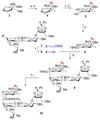Design and synthesis of potent Quillaja saponin vaccine adjuvants
- PMID: 20088518
- PMCID: PMC2820154
- DOI: 10.1021/ja9082842
Design and synthesis of potent Quillaja saponin vaccine adjuvants
Abstract
The success of antitumor and antiviral vaccines often requires the use of an adjuvant, a substance that significantly enhances the immune response to a coadministered antigen. Only a handful of adjuvants have both sufficient potency and acceptable toxicity for clinical investigation. One promising adjuvant is QS-21, a saponin natural product that is the immunopotentiator of choice in many cancer and infectious disease vaccine clinical trials. However, the therapeutic promise of QS-21 adjuvant is curtailed by several factors, including its scarcity, difficulty in purification to homogeneity, dose-limiting toxicity, and chemical instability. Here, we report the design, synthesis, and evaluation of chemically stable synthetic saponins. These novel, amide-modified, non-natural substances exhibit immunopotentiating effects in vivo that rival or exceed that of QS-21 in evaluations with the GD3-KLH melanoma conjugate vaccine. The highly convergent synthetic preparation of these novel saponins establishes new avenues for discovering improved molecular adjuvants for specifically tailored vaccine therapies.
Figures








References
-
- Jiang ZH, Koganty RR. Curr. Med. Chem. 2003;10(15):1423–1439. - PubMed
-
- Kwissa M, Kasturi SP, Pulendran B. Exp. Rev. Vaccines. 2007;6(5):673–684. - PubMed
-
- Dalsgaard K. Dansk Tids. Farm. 1970;44(8):327–331. - PubMed
-
- Kensil CR, Patel U, Lennick M, Marciani D. J. Immunol. 1991;146(2):431–437. - PubMed
-
- Kensil CR. Crit. Rev. Ther. Drug Carr. Syst. 1996;13(1–2):1–55. - PubMed
Publication types
MeSH terms
Substances
Grants and funding
LinkOut - more resources
Full Text Sources
Other Literature Sources
Medical

